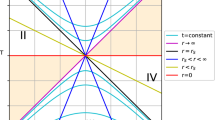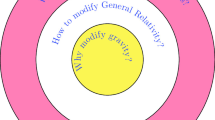Abstract
A statistical mechanism is proposed for symmetrization of an extra space. The conditions and rate of attainment of a symmetric configuration and, as a consequence, the appearance of gauge invariance in low-energy physics is discussed. It is shown that, under some conditions, this situation occurs only after completion of the inflationary stage. The dependences of the constants ℏ and G on the geometry of the extra space and the initial parameters of the Lagrangian of the gravitational field with higher derivatives are analyzed.
Similar content being viewed by others
References
K. A. Bronnikov and S. G. Rubin, Phys. Rev. D: Part. Fields 73, 124 019 (2006); arXiv:gr-qc/0510107.
S. G. Rubin, Zh. Éksp. Teor. Fiz. 133(4), 820 (2008) [JETP 106 (4), 714 (2008)].
M. Blagojević, Gravitation and Gauge Symmetries (Institute of Physics, Bristol, 2002).
J. B. Hartle and S. W. Hawking, Phys. Rev. D: Part. Fields 28, 2960 (1983).
A. Vilenkin, Phys. Lett. B 117, 25 (1982).
D. L. Wiltshire, in Cosmology: The Physics of the Universe, Ed. by B. Robson, N. Visvanathan, and W. S. Woolcock (World Sci., Singapore, 1996), p. 473.
M. J. Duff, L. B. Okun, and G. Veneziano, J. High Energy Phys. (online) 03, 023 (2002), arXiv:physics/0110060.
G. E. Volovik, arXiv:0904.1965 [gr-qc].
A. Vilenkin, Phys. Rev. D: Part. Fields 37, 888 (1988).
T. A. Brun and J. B. Hartle, Phys. Rev. E: Stat. Phys., Plasmas, Fluids, Relat. Interdiscip. Top. 59, 6370 (1999); arXiv:quant-ph/9808024.
A. B. Katok and B. Hasselblatt, Introduction to the Modern Theory of Dynamical Systems (Cambridge University Press, Cambridge, 1996; Faktorial, Moscow, 1999).
G. D. Starkman, D. Stojkovic, and M. Trodden, Phys. Rev. D: Part. Fields 63, 103511 (2001); arXiv:hep-th/0012226v2.
B. A. Dubrovin, A. T. Fomenko, and S. P. Novikov, Modern Geometry: Methods and Applications (Nauka, Moscow 1979; Springer, New York, 1985).
U. Günther, P. Moniz, and A. Zhuk, Astrophys. Space Sci. 283, 679 (2003); arXiv:gr-qc/0209045.
K. A. Bronnikov, R. V. Konoplich, and S. G. Rubin, Classical Quantum Gravity 24, 1261 (2007); arXiv:gr-qc/0610003.
I. Antoniadis and K. Benakli, Phys. Lett. B 331, 313 (1994); arXiv:hep-ph/9403290.
H. Davoudiasl and T. G. Rizzo, Phys. Rev. D: Part. Fields 76, 055009 (2007); arXiv:hep-ph/0702078.
M. Regis, M. Serone, and P. Ullio, Phys. Lett. B 663, 250 (2008); arXiv:hep-ph/0612286.
A. A. Starobinsky, Pis’ma Zh. Éksp. Teor. Fiz. 86(3), 183 (2007) [JETP Lett. 86 (3), 157 (2007)].
S. Nojiri and S. D. Odintsov, Int. J. Geom. Methods Mod. Phys. 4, 115 (2007); arXiv:hep-th/0601213v5.
L. M. Sokolowski, Acta Phys. Pol., B 39, 2879 (2008).
S. M. Carroll, J. Geddes, M. B. Hoffman, and R. M. Wald, Phys. Rev. D: Part. Fields 66, 024036 (2002); arXiv:hep-th/0110149.
G. E. Volovik, Proceedings of Conference “From Quantum to Emergent Gravity: Theory and Phenomenology,” Trieste, Italy, 2007 (Trieste, 2007), PoS(QG-Ph) 043.
J. Garriga and A. Vilenkin, Phys. Rev. D: Part. Fields 64, 023517 (2001); arXiv:hep-th/0011262.
A. D. Dolgov and F. R. Urban, Phys. Rev. D: Part. Fields 77, 083503 (2008); arXiv:0801.3090.
D. H. Lyth and A. Riotto, Phys. Rep. 314, 1 (1999); arXiv:hep-ph/9807278v4.
W. Lerche, D. Lust, and A. N. Schellekens, Nucl. Phys. B 287, 477 (1987).
S. Kachru, R. Kallosh, A. Linde, and S. P. Trivedi, Phys. Rev. D: Part. Fields 68, 046005 (2003).
Author information
Authors and Affiliations
Corresponding author
Additional information
Original Russian Text © S.G. Rubin, 2009, published in Zhurnal Éksperimental’noĭ i Teoreticheskoĭ Fiziki, 2009, Vol. 136, No. 6, pp. 1113–1120.
Rights and permissions
About this article
Cite this article
Rubin, S.G. On the origin of gauge symmetries and fundamental constants. J. Exp. Theor. Phys. 109, 961–967 (2009). https://doi.org/10.1134/S1063776109120061
Received:
Published:
Issue Date:
DOI: https://doi.org/10.1134/S1063776109120061




